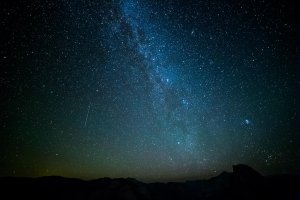jrista said:
Great shot! Looks like you had some nice, dark skies. I would say 14mm is a great focal length for wide field night sky photography.
Thank you! Yes we did, no moon, far from major light sources

I must admit, I did try to play with contrast, black etc. to try to emphasize the meteors. I didn't know about the meteor-to-star light ratio you mentioned earlier, so I was simply shooting in 25-30 second bursts. Next time I'll change it up!
CarlTN said:
At the risk of being criticized by the landscape photo police, you should have tried turning the camera sideways...since you are saying you missed some meteors overhead.
The color temperature of your Milky Way indeed is far too cool, but since it was intentional, I suppose it's a valid take on it. I've seen this look before. It's quite a nice shot...certainly the blue hue is appealing and draws one into the image. Of course if it's shot in RAW you can tweak on the color temperature however you wish later on.
If you are saying this was your first night sky shot...like ever...WOW that's quite a good result, no doubts about that!! You're on your way. I envy your Yosemite visit. It is a very highly traffic'ed park, though. For good reason, of course.
I had considered that, but to be more specific, the best ones we missed were all over; far to the left, right, so far overhead they were almost behind me, etc., so I left it. Plus I was shooting for timelapse, which I'll try to add shortly. What I did do is stop shooting at one point, and angle my camera much higher.
And yes, I think the blue helps emphasize the stars/meteors, although I suppose some may disagree. I also prefer a bluer look than a warmer one; I wonder if people that prefer a warmer is partly because they're used to being closer to light pollution? And I did shoot in RAW, so I can tweak this repeatedly. Which I'll probably do, because I know I could edit the shots better than I did.
Thank you! I mainly shoot landscape and am used to some techniques which help (mirror lock up, on a tripod, shutter release, manual focus etc), plus I have shot at night before; some steel wool, light painting, catching streaks of car lights, stuff like that. But this was my first time trying to milky way & meteor shots. It's kind of silly that it is, since I have regular access to Yosemite (I can reach the entrance in about an hour), and I've been to places like Arches & Zion. I'll definitely try to do more night photography in the future & get better at it.



